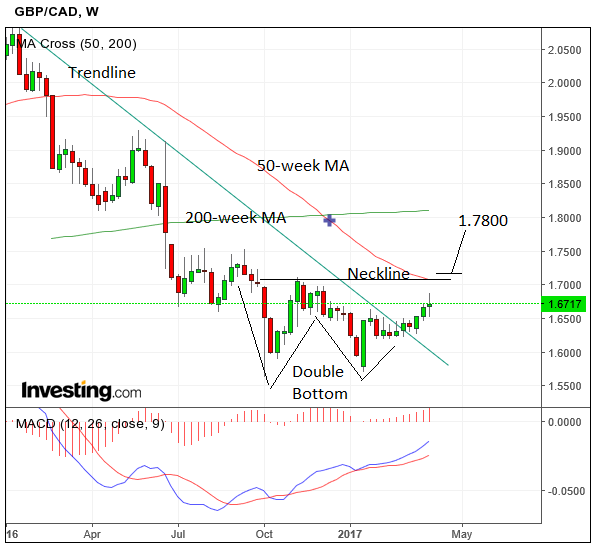Studies Suggest GBP/CAD Likely to Extend Higher Over Coming Weeks

The Canadian Dollar got off to a slightly subdued start to the second quarter on caution ahead of big data releases from north of the border that will help shape sentiment in the weeks ahead.
CAD has found some underpinning recently in the Canadian economy which has largely defied the Bank of Canada’s recent cautious assessments.
It also helped that the price of oil closed Q1 above the key $50 level.
"To keep the party alive, however, the loonie would need to survive critical Canadian data Wednesday on trade and Friday on the job market. Forecasts call for a smaller trade surplus and a cooler pace of hiring, outcomes that, if realized, could leave the loonie vulnerable to a spate of weakness," says Joe Manimbo, an analyst with Western Union.
Our studies of the Pound to Canadian Dollar exchange rate confirms the longer-term weekly chart to be the most compelling as it still shows a strong upside bias.
The short-term chart is a little more complicated as we saw the strong rise in GBP/CAD fail last week which might suggest near-term weakness.
But those looking at this exchange rate from a multi-week timeframe should note the GBP/CAD pair has broken through a major trendline and started to move higher.

It has formed what is probably a double-bottom reversal pattern, made up of two troughs at roughly the same level, forming a shape much like the letter ’W’.
The pattern is a bullish reversal sign and is activated when the exchange rate crosses its ‘neckline’ by rising above the high of the intervening peak between the two troughs.
The price expectation from such a move would be to rise the same height as the pattern extrapolated higher again from the level of the neckline.
This indicates a target at 1.7800, with confirmation coming from a move above the neckline and the 50-week moving average (MA) at 1.7150.
Overall the Canadian Dollar benefits from a positive seasonal bump in April as is tends to rise when crude oil prices rise because oil is Canada’s premier export.
Oil is seasonally biased to rise in April due to refineries reopening after closing in March for maintenance and restocking on crude oil again.
However, this is also the case for the Pound which also tends to rise in April because a high constituent of the FTSE 100 are oil and gas stocks and the Pound gets a boost from outside investors piping money into the UK to purchase these stocks in April.
Therefore the two gains may cancel each other out.
Canadian Data to Watch this Week
In the week ahead there is some significant data scheduled for release from Canada in particular Canadian Employment figures on Friday, April 7 at 13.30 GMT.
Employment is forecast to rise 5.0k and the Unemployment to increase by a basis point to 6.7%, and if so we shall probably not see much of a reaction from CAD.
The Canadian Business Outlook Survey is also important and is released on Monday at 15.30 GMT.
CAD has benefited from a strong run of positive data recently so a continuation of that trend will help support it.
UK Data to Watch this Week
The main data releases in the week ahead for Sterling will be UK Purchasing Manager surveys (PMIs) for March, which are important forward-looking gauges of sentiment in major sectors of the economy.
Manufacturing PMI is out on Monday, April 3 at 9.30 GMT and is expected to remain unchanged at 54.6.
Construction PMI is out on Tuesday at the same time and is forecast to remain at 52.5.
Finally, Services PMI is released on Wednesday at the same time and is expected to rise two basis points to 53.5 from 53.3 previously.
“This week’s PMI surveys for March should provide further evidence that the economy lost some momentum in the first quarter, and that manufacturing output growth probably outpaced services again," says Paul Hollingsworth at Capital Economics in a note seen by Pound Sterling Live.











